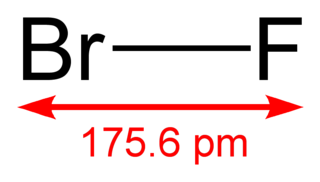This page is based on this
Wikipedia article Text is available under the
CC BY-SA 4.0 license; additional terms may apply.
Images, videos and audio are available under their respective licenses.

Hydrogen bromide is the diatomic molecule with the formula HBr. It is a colorless compound and a hydrogen halide. Hydrobromic acid is a solution of HBr in water. Both the anhydrous and aqueous solutions of HBr are common reagents in the preparation of bromide compounds.
An interhalogen compound is a molecule which contains two or more different halogen atoms and no atoms of elements from any other group.

Sodium bromide is an inorganic compound with the formula NaBr. It is a high-melting white, crystalline solid that resembles sodium chloride. It is a widely used source of the bromide ion and has many applications.

Iron(III) bromide is the chemical compound with the formula FeBr3. Also known as ferric bromide, this red-brown odorless compound is used as a Lewis acid catalyst in the halogenation of aromatic compounds. It dissolves in water to give acidic solutions.
The zinc–bromine flow battery is a type of hybrid flow battery. A solution of zinc bromide is stored in two tanks. When the battery is charged or discharged the solutions (electrolytes) are pumped through a reactor stack and back into the tanks. One tank is used to store the electrolyte for the positive electrode reactions and the other for the negative. Zinc bromine batteries from different manufacturers have energy densities ranging from 34.4–54 W·h/kg.
Tin(II) bromide is a chemical compound of tin and bromine with a chemical formula of SnBr2. Tin is in the +2 oxidation state. The stability of tin compounds in this oxidation state is attributed to the inert pair effect.

Iron(II) bromide is a chemical compound with the chemical formula FeBr2. The anhydrous compound is a yellow or brownish-colored paramagnetic solid. Several hydrates of FeBr2 are also known, all being pale colored solids. It is a common precursor to other iron compounds in research laboratory, but no applications exist for this compound.

Calcium bromide is the name for compounds with the chemical formula CaBr2(H2O)x. Individual compounds include the anhydrous material (x = 0), the hexahydrate (x = 6), and the rare dihydrate (x = 2). All are white powders that dissolve in water, and from these solutions crystallizes the hexahydrate. The hydrated form is mainly used in some drilling fluids.

Mercury(I) bromide or mercurous bromide is the chemical compound composed of mercury and bromine with the formula Hg2Br2. It changes color from white to yellow when heated and fluoresces a salmon color when exposed to ultraviolet light. It has applications in acousto-optical devices.
Organobromine compounds, also called organobromides, are organic compounds that contain carbon bonded to bromine. The most pervasive is the naturally produced bromomethane.

Bromine dioxide is the chemical compound composed of bromine and oxygen with the formula BrO2. It forms unstable yellow to yellow-orange crystals. It was first isolated by R. Schwarz and M. Schmeißer in 1937 and is hypothesized to be important in the atmospheric reaction of bromine with ozone.
It is similar to chlorine dioxide, the dioxide of its halogen neighbor one period higher on the periodic table.

Bromine azide is an explosive inorganic compound with the formula BrN3. It has been described as a crystal or a red liquid at room temperature. It is extremely sensitive to small variations in temperature and pressure, thus extreme caution must be observed when working with this reagent. This property of bromine azide has led to difficulty in discerning its crystal structure, with explosions occurring at Δp ≥ 0.05 Torr and also upon crystallization. Despite this, a crystal structure of bromine azide has been obtained using a miniature zone-melting procedure with focused infrared laser radiation. In contrast to IN3, which forms an endless chain-like structure upon crystallization, BrN3 forms a helical structure.
Dibromine monoxide is the chemical compound composed of bromine and oxygen with the formula Br2O. It is a dark brown solid which is stable below −40°C and is used in bromination reactions. It is similar to dichlorine monoxide, the dioxide of its halogen neighbor one period higher on the periodic table. The molecule is bent, with C2v molecular symmetry. The Br−O bond length is 1.85Å and the Br−O−Br bond angle is 112°. A related diatomic molecule bromine monoxide (CAS#15656-19-6 ).

Dibromine pentoxide is the chemical compound composed of bromine and oxygen with the formula Br2O5. It is a colorless solid that is stable below −20 °C. It has the structure O2Br−O−BrO2, the Br−O−Br bond is bent with bond angle 121.2°. Each BrO3 group is pyramidal with the bromine atom at the apex.
Dibromine trioxide is the chemical compound composed of bromine and oxygen with the formula Br2O3. It is an orange solid that is stable below −40 °C. It has the structure Br−O−BrO2 (bromine bromate).
The Br−O−Br bond is bent with bond angle 111.2° and the Br−O−BrO2 bond length is 1.85Å.
Sodium hypobromite in the inorganic compound with the formula NaOBr. It is usually obtained as the pentahydrate, so the material that is usually called sodium hypobromite has the formula NaOBr.5H2O. It is a yellow-orange solid that is soluble in water. It is the Na+ salt of OBr-. It is the bromine analogue of sodium hypochlorite, the active ingredient in common bleach. In practice the salt is usually encountered as an aqueous solution.













